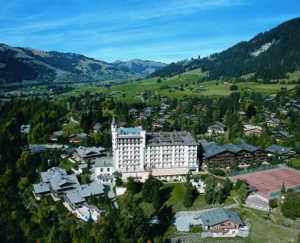Tennis On The Road
By Oliver Hartman

Keven Lau Photography
A fisherman goes to a remote Scandinavian river for salmon, a skier spends two weeks in British Columbia for powder, and a yogi flies to New Zealand for a yoga retreat.
Well, tennis players also travel the world for their sport. I was a varsity player in college and have taught tennis in Maine, Massachusetts, San Francisco, New York City and Switzerland. Even when not working as a pro, I always bring my rackets when I travel. It’s an easy way to meet locals and stay active on a trip. In Nicaragua, in Hawaii and Argentina I became known as “the tennis guy” and was quickly absorbed into a group of people who share a love of tennis.
Here’s a sampling of ways tennis enthusiasts can travel the world, racquets in hand or not, to get their fix.
Watching the Pros
For fans eager to see the world’s top players in action, the best  bets are package tours that cater to the Grand Slams--US Open, Australian Open, French Open and Wimbledon. These comprehensive trips include tickets, accommodations and local cultural excursions. bets are package tours that cater to the Grand Slams--US Open, Australian Open, French Open and Wimbledon. These comprehensive trips include tickets, accommodations and local cultural excursions.
For travelers who like logistics handled for them, it is an easy way to see the big guns play at the most important tennis events of the year. Take a look at Vermont-based Grand Slam Tennis Tours. In business since the early 90s, they offer full-service tours to the Majors as well as other significant tournaments around the world.
Tennis Camps
For someone looking to improve his or her game, going to a tennis camp is a great option. The group dynamic makes them more social and the shared pain of six hours on court a day makes bonding easy. Camp sessions are typically targeted for juniors or adults specifically, not both. They run the gamut from simple stroke improvement clinics to grueling tournament preparation. Some even incorporate a holistic philosophy and have names like “Unleashing the Tennis Player Within” and focus on breathing, concentration, relaxation and the Zen of tennis. These camps are sometimes run at resorts, at universities or stand-alone tennis training facilities. What makes them camps, per se, is the fact that there is a structured program that lasts one week or more. more.
One outstanding example: Tennis Week camps offered by Roy Emerson (winner of 28 Grand Slam titles), at the Gstaad Palace in Switzerland (left). His intensive camps cater to players over 16 years old and include 27.5 hours of court time.
Tennis Retreats/Resorts
At tennis resorts and retreats, you can play as much or as little tennis as you like. The larger resorts tend to offer a myriad of tennis options including multi-day clinics, private lessons, group cardio tennis workouts and round robin tournaments. Many also can arrange for hitting partners. Smaller tennis retreats may not necessarily have structured clinics, but they’ll typically have a staff pro available for private lessons.
Between the two, there are mid-size resorts and hotels where tennis is given a lot of attention, but it’s not the only focus. For example, at Rosewood Little Dix Bay in the British Virgin Islands, guests can use the seven courts for leisure play or get a little more serious with the free one-day beginner clinic, a private lesson, or a specific clinic on serves, returns, maybe doubles strategies. There are also programs for kids. When not on the court, there’s plenty of snorkeling, boating and general island vacationing to do.
Open Courts
In many destinations, there are public courts that are free or available for rent by the hour.
To find them, start by asking locals and staff at your hotel. If they can’t point you in a specific direction, look into finding public schools, universities and racket clubs. Local departments of tourism can be helpful, and occasionally a web search can pull up great results. Still, locals are the best resource, and you can even try to get in touch with them before you leave for your trip by networking through Facebook or contacting area racket clubs or sporting stores by phone or e-mail. Racket clubs can be finicky with guest policies, but some are open to per-hour rentals by non-members. With not too much trouble, you should be able to find yourself out on a court just about anywhere you go.
Photo Credits: Top photo by Keven Lau; doubles by Ann Shepphird.
|
|
|

